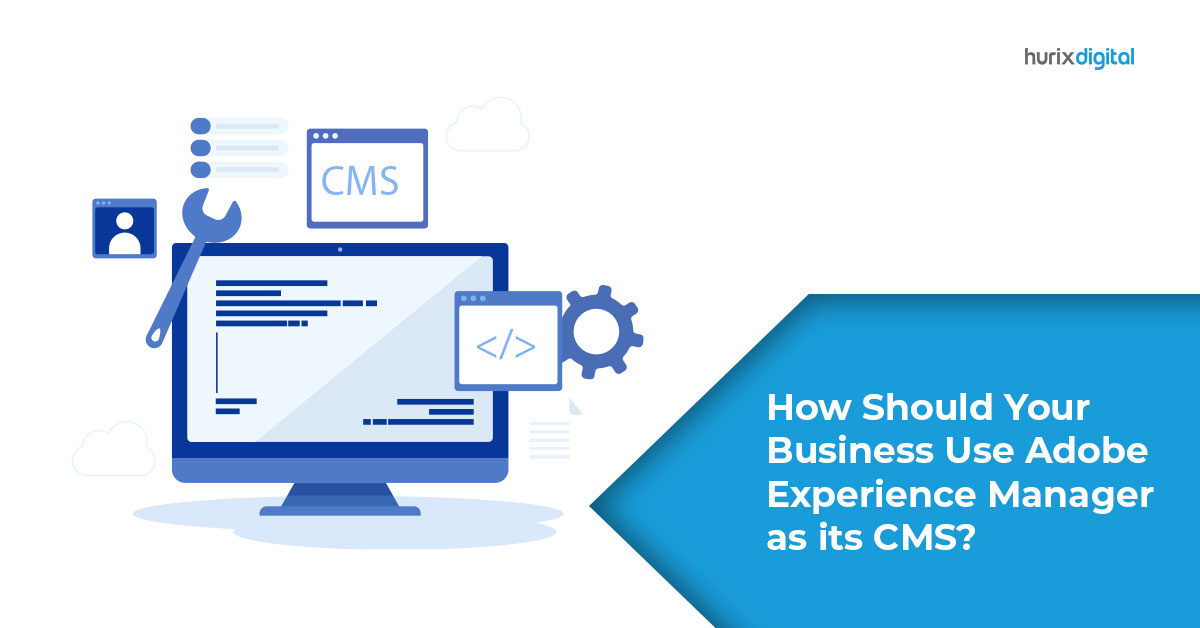How Should Your Business Use Adobe Experience Manager as its CMS?
Joomla, WordPress, and Drupal are all excellent choices for enterprise-level content management systems (CMS). However, depending on the size of your team or company, it could take months to get up to speed on each one. Setting up and getting familiar with a CMS explicitly made for business is much easier.
A content management system (CMS) has numerous benefits for businesses. Consider an example: Your business has maintained an e-commerce website for several years, achieving high search engine rankings. Now, realizing that users view 4.2 times more products per session on mobile apps than on mobile sites and exhibit a three times higher conversion rate, you’re aiming to enter the mobile app domain.
How can you accomplish this effectively without compromising your brand identity? You can leverage your CMS to manage content from the website and seamlessly render it in your new mobile app, reducing manual work and wasted time.
Another crucial use case of CMS is ensuring that search engines can effectively rank your website by more than just relying on meta tags. A CMS can incorporate integrated SEO tools designed to assist you in reaching a broader audience.
As an Adobe Managed Services solution, Adobe Experience Manager (AEM) combines seamless user experience, intuitive user interface design, social collaboration, and marketing automation into one tool to help your business reach its online objectives faster.
Table of Contents:
- AEM as a CMS for Your Business – A Brief Overview
- How to Use Adobe Experience Manager as a Content Management System?
- Process in AEM
- AEM Implementation
- AEM Best Practices
- Wrapping Up
AEM as a CMS for Your Business – A Brief Overview
Adobe Experience Manager is a Content Management System (CMS) that provides powerful tools to manage your website. It also makes publishing content, creating landing pages, and building microsites easy.
Web designers and developers love AEM because it’s highly customizable, allowing them to create any desired experience. The critical question is: How can your business use Adobe Experience Manager as its CMS?
The tool provides an all-inclusive solution for producing, publishing and maintaining content on your website. Here are some features that make AEM the ideal CMS solution:
- You can manage all of the content on your website, including text, graphics, and video, using the Adobe Managed Services solution.
- You may use it to develop dynamic content that alters in response to user searches. For instance, searching for “flowers” can provide different results than searching for “gifts.”
- You can manage consumer interactions.
- To know where to concentrate your marketing efforts in the future, you can track which pages users visit most frequently and what kinds of products/services they purchase.
How to Use Adobe Experience Manager as a Content Management System?
AEM software enables you to easily develop user-friendly websites and mobile applications for your clients. Additionally, you can utilize it to coordinate social media efforts and enhance channel-specific conversion rates.
AEM is a comprehensive solution that comprises a content management system (CMS), a content library, analytics, user experience (UX) tools, and performance optimization tools. When managing your website, blog, or app with AEM, you may rapidly create content using drag-and-drop and template capability.
Incorporating a CMS into your marketing approach is essential, as it enables workflow optimization and efficiently expands your audience using minimal resources. A well-designed website or app can raise sales potential, traffic, and brand visibility. Organizations can create these assets using Adobe Experience Manager without consultants or outside developers.
Also Read: Best Practices for Implementing AEM and Platform Services in Your Organization
Process in AEM
Making a workflow for your website is the first step in using AEM. With the use of workflows, you may add several forms of content to your website, like live chat windows, movies, and images. You can control the types of people accessing each item by assigning them certain roles within your AEM workflow. Even more, workflows can be made for your website if necessary.
AEM also makes it easy for multiple people in your organization to collaborate on a single project simultaneously —editing text or updating images. So if you need to make changes on the fly or make last-minute tweaks before launch, there’s no need for everyone to wait until the project manager has time to update their code; everyone can work at once!
Also Read: AEM and Platform Services: Empowering Marketing Campaigns and Automation
AEM Implementation
Adobe Experience Manager (AEM) uses Adobe’s proprietary framework to create websites, apps, and other digital experiences. It’s part of the Adobe Marketing Cloud, which includes tools like Adobe Campaign and Analytics.
For example, suppose your customers fill out forms on your website and expect to receive confirmation pages from the server rather than from their browsers’ cache files. You can integrate AEM with your web server to send responses directly from there instead of from browser cache files stored locally on users’ computers.
Here are some examples of how AEM can be used:
1. Content Authoring
The AEM content authoring tool is designed to help you build engaging mobile-first experiences. It comes with a drag-and-drop interface that makes it easy to create content pages, blog posts, and other types of online assets. The CMS also offers powerful media tools to help you enhance your visuals.
2. Analytics
The AEM analytics dashboard provides real-time insights into user engagement on your site so that you can improve conversion rates and increase sales. The dashboard gives you access to site traffic, page views, bounce rates, and time spent on the site – all of which can help you make informed decisions about what elements should be updated or removed from the site.
Here are some questions to ask yourself before choosing AEM as your CMS platform:
- Is your website focused on content?
- Do you need to create multiple websites?
- Do you have a large user base?
- Are you looking for enterprise-grade security?
- Do you want to scale content management as your company grows?
AEM Best Practices
Here are some best practices for utilizing AEM as your CMS, whether you run a small business or a major corporation:
1. Manage Content with AEM
A Content Management System’s main objective is to manage information across all platforms, including social media, mobile, and the web. Adobe Experience Manager is one of the best solutions available to do this.
2. Combine AEM with Additional Tools
AEM integration with additional tools like Google Analytics or HubSpot can help you expand the functionality of your website. This will give you a better understanding of how visitors use your website and what they find appealing so you can tweak it over time.
3. Select an Editor That Facilitates the Productivity of Your Team
For instance, if you employ engineers comfortable with coding, you might use Adobe Experience Manager for Digital Publishing (AEM DP). Because this editor includes built-in HTML5 code support, developers may produce richer content with less code.
Try Adobe Experience Manager Forms (AEM Forms), which enables non-technical people to design forms without coding them from scratch, if your team doesn’t contain developers or you want something more straightforward.
4. Check to See if Your Website is Mobile-Friendly
Use responsive web design strategies to make the site flexible to multiple screen sizes without reloading the page or using different URLs or code snippets to accommodate different devices. Additionally, a responsive design makes it simpler for search engines to crawl swiftly and index content from your website, making it easier for users to locate what they’re looking for.
Wrapping Up
Here’s the bottom line: Adobe Experience Manager is an excellent system for managing content to varying levels of complexity, and it will help you add some functionality to your website that you may not have had before.
You may wonder what content elements should be managed via Adobe Experience Manager. Our answer at Hurix Digital is as many as you want. With an enterprise CMS that is robust, secure, and intuitive, your business can manage all its disparate content in one location. You can get in touch with Hurix Digital and transform your CMS experience!

SVP & Head – Hurix Technology Solutions
Global Delivery head with 25 years of working experience in NYC investment banks and fintech companies. Hands-on technology delivery management and program management, accountable for stakeholder relationships, Strategic roadmap, P&L, Revenue growth, Account Management, and employee satisfaction.









